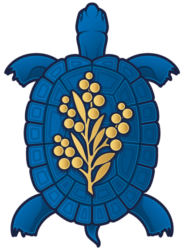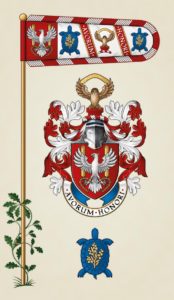
My Personal Coat of Arms Expounded.
Notwithstanding I am the holder and recipient of a number of ancestral and foreign nobiliary titles of honour and dignity, knighthoods, medals and awards (most of which carry with them appellations and post-nominals), the foregoing can neither feature, nor be alluded to in a Coat of Arms from the Crown as they do not fall in the ambit of State honours and awards within the Commonwealth of Nations.
Additionally, ‘foreign’ (sometimes over-embellished) and new Quartered Arms (which traditionally implied that an Armiger, or one of his male ancestors, had inherited Coats of Arms from Heraldic Heiressess whom they acquired the lands of), or those bearing registered or controlled ‘charges’ (the likes of lions, roses, or heraldic devices of nations and states) cannot be granted from the Crown, so for the purposes of all my future activities within the Commonwealth (and the fact that I was born in Bridgnorth, England) I will defer to my Grant of Armorial Ensigns from Her Majesty’s College of Arms.
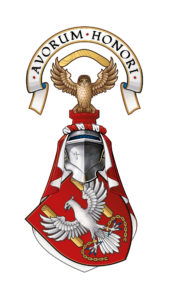
In the creation of my Coat of Arms and heraldic ensigns, I worked closely with York Herald (Michael ‘Peter’ Desmond O’Donoghue) over a period of months to create a design that would be bold and as simple as possible, yet sublime, personal and representative of me in a subtle and allusive way.
Granting Authority: Kings of Arms Garter, Clarenceux, Norroy and Ulster; Her Majesty’s College of Arms: London; 2019. College Reference: Grants 182/305.
Earl Marshall’s Warrant: 14 May 2019.
Letters Patent: 7 May 2020.
Official Publication: 12 August 2020.
Official Gazettal: October 2020.
Preferred Style – by Letters Patent: George William Helon Esquire.
International Registrations: Heraldry of the World.
The Blazon (i.e. the Formal Description) of my Granted Armorial Ensigns:
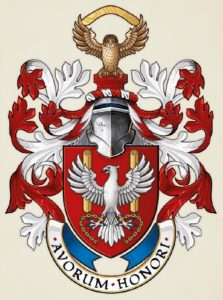
ARMS: Gules an Eagle displayed Argent attached to each foot by a Manacle a broken Chain the Wings surmounting on either side a Scroll palewise Or.
CREST: Upon a Helm with a Wreath Argent and Gules Perched on the top of a Tower Gules a Rufous Owl affronty displayed proper supporting with the Wing Tips a Boomerang Or.
MANTLING: Gules doubled Argent.
BADGE: A Turtle palewise Azure charged on the Shell with a Sprig of Golden Wattle Or.
MOTTO: AVORUM HONORI (‘For the Honour of Our Ancestors’).
STANDARD: As pictured below.
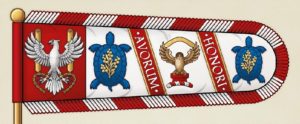
The Tinctures (Metals & Colours) and their Symbolism:

Argent: SILVER, or WHITE (a Metal) – signifies honour, truth, sincerity, peace, innocence, purity and virtue.
Azure: BLUE (Colour) – ‘the colour devoted to the Virgin Mary by the Roman Catholic Church’, represents the colour of an eastern sky on a clear day; indicative of piety, sincerity, loyalty, chastity, truth, strength and faith; strong on commitments and ties. Symbolic of divine eternity, and of human immortality
Gules: RED (Colour) – ‘the martyr’s colour’, symbolic of nobility, generosity, excellence, fortitude, boldness, ferocity, physical power, military strength, the warrior and martyrdom – sacrifice! Denotes spiritual virtues, ardent love towards God and one’s neighbour, valour and energy.
Or: GOLD (a Metal) – implies wisdom, elevation of mind, generosity, glory, faithfulness, devotion, loyalty and faith. Symbolic of eternity, royalty, power and strength.
The Crest, the Devices and their Symbolism:

Boomerang: Aloft the owl supports a gold boomerang at the tips of its out-stretched wings. Knowledge is as valuable, if not more so than gold, but unlike gold that is heavy to lift, knowledge is weightless, yet powerful and potent, words as light as air but as heavy as a hammer; what goes around, comes around!
Owl: The Rufus Owl (indigenous to Eastern Queensland), recognises the esteemed tribute bestowed upon me by Aboriginal Tribal Elders who named me ‘Buralnyarla’ (‘White Owl’ – keeper of the knowledge) in recognition of the work undertaken and completed for, and on behalf of the Gooreng Gooreng Aboriginal Peoples of South-East Queensland.
The owl is ever-vigilant, a symbol of prudence and wisdom.
Tower: An emblem of grandeur and society, and signifying spiritual power and strength, vigilance and safety, a tower was traditionally granted to one who had faithfully held one for his sovereign, or who had captured one by force or strategy.
The red tower upon which the owl is perched alludes to my place of birth, Bridgnorth in Shropshire (England) where the landscape is dominated by the ruins of Bridgnorth Castle, a Royalist stronghold which Oliver Cromwell had his Roundheads destroy after a vicious and bloody three-week siege in 1646.
The colour red is symbolic of the blood spilled. Blood – that which binds and courses through the veins of all of our ancestors throughout the aeons.
The Helm (Helmet), Wreath and Mantling:
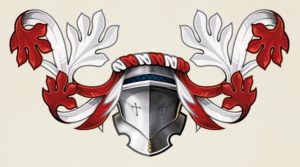
Upon a helm a wreath argent and gules mantling gules doubled argent.
A helm of course is the helmet. The style of helmet displayed varies according to rank and social status of the Armiger (a person entitled to heraldic arms); in this case the closed or tilting helm is indicative of an Esquire or gentleman.
The wreath, also known as a torse, is a six-fold roll of twisted fabric laid about the top of the helmet and the base of the crest. It has the dual purpose of masking the join between helm and crest, and holding the mantling in place.
Wreath argent and gules means the first twist will be silver or white (a metal), the second red (a colour), alternating.
From the helmet hangs the mantling, or lambrequin which is usually rendered in the two principal colours of the Arms; in this case red on the outside, with a silver or white lining.
When worn, mantling was made of linen or other cloth and shielded the wearer from the sun’s rays; it also served to snare or deflect sword cuts – thus it is often depicted slashed, torn or ripped.
Mantling gules doubled argent simply means the outside of the mantle is red, whilst the inner lining is silver or white.
The Field and its Symbolism:
Escutcheon (Shield): A red field symbolic of nobility, generosity, military strength, the warrior and martyrdom – sacrifice; indicative of the primary colour of the coat of arms of Poland where generations of my family lived before they were arbitrarily arrested and deported to Siberia at gunpoint by the dreaded Soviet NKVD during the early hours of the morning of Saturday 10 February 1940.
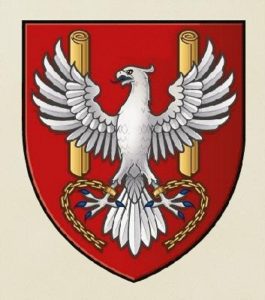
The Charges (Emblems and Devices) and their Symbolism:
Eagle: The white eagle (rendiscent of the Polish Orzeł Biały) is depicted with its wings and legs outstretched, its head turned to the right, in a pose known in heraldry as ‘displayed’ which is representative of speed and wisdom. The eagle’s plumage, as well as its leg scales are white with gradient shading suggestive of a bas-relief – a solid and powerful sculpture. In homage to my Polish ancestry, symbolic of nobility, grace, power, courage, freedom and fortitude of mind.
A symbol of hope, of strength and of resurrection; the latter is based on the early belief that the eagle, unlike other birds, periodically renewed its plumage and its youth by flying near the sun then plunging into the water.
Manacles: Although originally indicative of bondage, slavery and servitude, manacles have come to signify victory, salvation, redemption and resurrection.
Attached to each foot of the eagle is a manacle with a broken chain symbolic of the freedom of my parents and their families from the bondage and suffering their families endured during, and after World War II.
Chains: Symbolic of captivity and servitude. Being broken, the chains are indicative of ‘freedom’ from persecution and oppression, exile to the inhospitable wastelands of Siberia and forced slave labour at the hands of the Soviet NKVD Secret Police.
Scrolls: The first form of editable record keeping texts, used in Eastern Mediterranean and ancient Egyptian civilizations were scrolls.
Whilst one of the scrolls alludes to Judaism and the Torah – scholarship, the Hebraic roots of the Helon family (as well as to my work as an author, historian and genealogist), the other scroll is a reference to my appointment as a Justice of the Peace (Qualified) for the State of Queensland; for Justices of the Peace undertake many important administrative and legal functions.
The Motto.

AVORUM HONORI: For the Honour of Our Ancestors.
The Badge and its Symbolism:
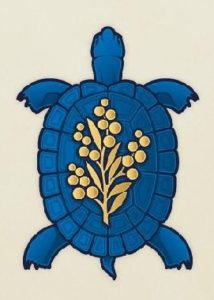
Turtle: Regarded as a symbol of longevity, invulnerability to attack, patience and practicality; strength, endurance and time, a turtle is symbolic of independence and solitude because it takes its home with it and is well protected.
A turtle is a reptile of the order Chelonians; an aquatic attribute. The surname Helon traditionally means ‘sand’ in Hebrew, but in the Polish language it means ‘Żołw’ – a turtle. The heraldic turtle is a canting badge, i.e. it pictorially alludes to, and subtly represents the surname Helon.
There is a reference to this in Louis Ginzberg’s (1911) The Legends of the Jews. Philadelphia: The Jewish Publication Society. Vol. 3; p. 221. ISBN 0-8018-5892-5.
“Corresponding to the occupation of the tribe of Zebulun, its prince was called Eliab, “the ship,” son of Helon, “the sand,” for this tribe spent its life on ships, seeking “treasures hidden in the sand.”
A turtle needs not a compass to find its way home, only inherent instinct.
Wattle: Golden Wattle (Acacia Pycnantha) is Australia’s national floral emblem. As one species of a large genus of flora growing across Australia, the golden wattle is a cherished symbol of unity, remembrance and reflection, celebration, of joy, and of sadness.
Wattle is ideally suited to withstand Australia’s droughts, winds and bushfires.
The resilience of wattle represents the spirit of the Australian people – enduring; just like the Helon family who have survived deportation, exile, slave labour, starvation, murder, and persecution.
Connect with Me!
Copyright (C) George W. Helon: Australia; 2018-2025.
Now with SSL Certification for your Security!


